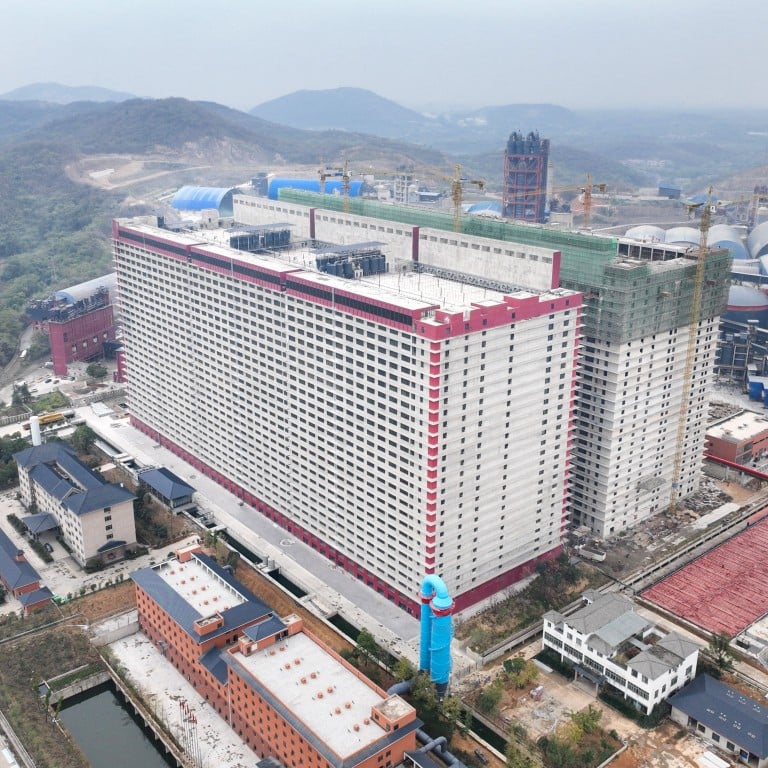
China’s skyscraping pig farms are high on the hog, and their advanced tech feeds into food-security drive
- High-rise structures such as one in Ezhou, Hubei province, are becoming increasingly common across China and utilise the most advanced smart-farming technologies
- Beijing has been ramping up efforts to increase food production in the face of climate change, supply-chain upheavals and turbulent geopolitical tensions
A 26-storey skyscraper in central China’s Hubei province, towering over every building nearby, could easily be mistaken for a typical residential complex. The imposing structure indeed features air-conditioned rooms, an area for exercise, and windows with a sweeping view of the streets far below.
But the residents are not affluent white-collar workers, nor are they local families who got a good deal on rent – they are pigs.
Smart-farming technologies are being integrated into all sorts of agricultural practices across China to ensure a stable food supply for 1.4 billion people. The utilised tools include artificial intelligence, the Internet of Things, big data, cloud computing, and other types of digital technology.
‘A new era’: China embraces GM corn, soybeans after years of heated debate
A joint announcement by the Ministry of Natural Resources and the Ministry of Agriculture and Rural Affairs in 2019 also allowed for multistorey buildings to be used as farming facilities.
Fuelled by favourable policies and technological advancements, the value of China’s smart-livestock-farming market is projected to reach 47.7 billion yuan (US$6.52 billion) by 2026, according to a report published last year by LeadLeo, a market research institution.
“We are now entering an era of digitisation, and undoubtedly, smart farming is an inevitable future, as well as a representation of technological advancement,” said Zhang Shuai, a professor specialising in pig-farming technology at China Agricultural University.
The eye-catching pig farm in Hubei’s Ezhou, south of the Yangtze River, opened last October. And another one is currently being built right next door. At full capacity, the two buildings are expected to produce 1.2 million fully grown pigs a year.
As very few young people are willing to engage in frontline livestock farming … the livestock industry will become less labour-intensive
Proponents of high-rise pig farms say they use a fraction of the land, and the use of advanced technology allows for only about a dozen workers to manage thousands of pigs on each floor.
Such farms are also being used in Sichuan, Guangdong and Shandong provinces.
Beijing has been ramping up efforts to increase food production in the face of climate change, supply-chain upheavals and turbulent geopolitical tensions.
As educated young workers are increasingly reluctant to get their hands dirty, smart farming also provides a solution to the labour shortage, according to Zhang.
“As very few young people are willing to engage in frontline livestock farming, it is inevitable that the future model of the livestock industry will become less labour-intensive, or even automated,” Zhang said. “This is a challenge shared by China and other countries.”

However, when that down-and-dirty pigpen work is left to the machines, more people might be interested in working in the livestock farming industry, Zhang added.
Pork is a staple meat on Chinese dinner tables, and China is the world’s largest producer and consumer of pork.
The country consumes nearly 700 million pigs each year, and that represents around 60 to 70 per cent of Chinese people’s meat consumption. It also accounts for roughly half of the global pig population. In 2022, China produced about 55.4 million tonnes of pork.
The nation’s 14th five-year plan emphasised the need to ensure stable pig production, as well as to maintain a self-sufficiency rate of around 95 per cent, with an annual output of about 55 million tonnes of pork.
Other parts of China have already leveraged digital and intelligent devices to make agricultural innovations. These include an aquaculture system that can continuously monitor seawater parameters such as pH levels and dissolved oxygen, helping farmers breed more fish.
Can deep-sea fishing feed China, or will the haul be too costly?
However, Zhang contended that, despite Ezhou’s utilisation of smart-farming technologies, the viability of high-rise pig farms should be critically discussed, as they are not suitable everywhere.
He said that multistorey pig farms have not gone mainstream for a reason – the treatment of faeces requires corresponding areas of land, and it could be a major challenge for such pig farms to process massive amounts of pig manure.
“We encourage a moderate-scale approach to farming, one that emphasises sustainability and ecological recycling,” he said. “This entails the promotion of environmentally friendly and well-balanced livestock farming.”
Another significant challenge in high-rise pig farming is disease prevention and control.
“Despite the implementation of air-filtration systems … many diseases among pigs can be transmitted through droplets and the air, spreading rapidly” and exposing the animals to greater health risks, Zhang explained.

